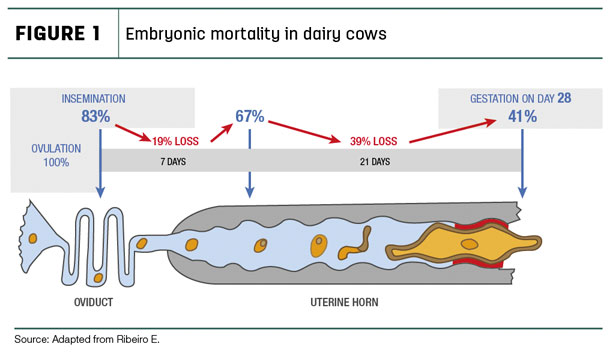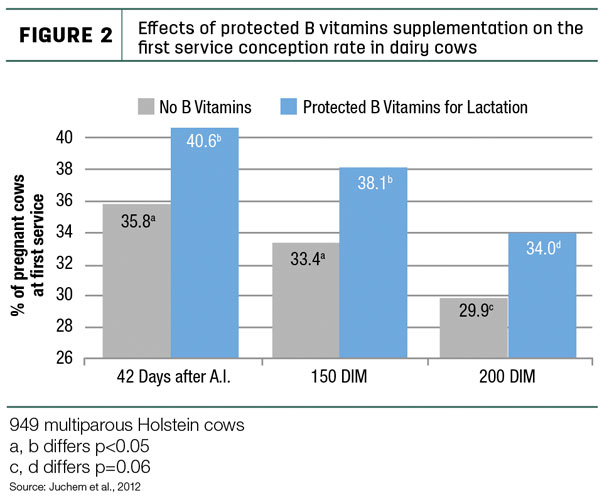Moreover, days open range from 154 to 127, respectively, for less- and more-performing herds. This difference of 27 days will have a significant economic impact, as each day open will cost about $4, equating to an annual difference of $108 per cow or $10,800 for a herd of 100 cows.
What are the limiting factors for the reproductive performance of cows?
Several factors will impact reproductive performance, such as cow health around calving, cow comfort, heat stress and loss of body condition before calving and in early lactation. In addition, it is essential to properly feed the cow before calving to ensure her ovarian cycle is functional very early in lactation. A delayed ovulation will result in fewer cows pregnant early. In fact, only 45% of cows will be pregnant at 150 days in milk (DIM) when their first ovulation occurs after 50 DIM, compared to 75% when they ovulate earlier.
Although heat detection and insemination success are still an important challenge, there is another very important factor that will reduce reproductive performance, which is the early loss of the embryo. Indeed, there is evidence of a high loss of embryos during the first 28 days after insemination – that is 19% loss in the first week and another 39% until the fourth week after insemination. This means only 41% of cows will still be pregnant at 28 days when 83% of cows have received fertilized eggs (see Figure 1).

Nutrition is part of the solution
Nutritional composition of feed, including energy, protein (amino acids), minerals and vitamins A, D3 and E concentration, as well as other nutrients such as B vitamins, plays a key role in reproductive performance.
Some B vitamins have specific functions which will improve reproductive performance by stimulating or regulating the cow’s energy metabolism (fat and glucose synthesis) and protein synthesis and by improving immune function, follicular and early embryo development. In humans, it is known that deficiency of pyridoxine (B6) or vitamin B12 was associated with early pregnancy loss. In cattle, folic acid plays an important role in embryo cellular development. Therefore, supplementation with specific B vitamins would help to improve reproduction in dairy cows.
Feed supplementation remains the most practical and effective method for the producer; however, B vitamins need to be rumen protected since they are rapidly degraded by rumen microbes. They must be protected in order to reach the intestine where they will be absorbed.
An important study with 949 multiparous cows fed with a specific blend of rumen-protected B vitamins (folic acid [B9], pyridoxine [B6], pantothenic acid [B5], biotin [B8] and B12) from 22 DIM until cows were confirmed pregnant showed an improvement in reproductive performance. Conception rate at first service at 42 days after insemination was improved by 13% for the group supplemented with protected B vitamins. This improvement remained constant until 200 DIM for this same group (Figure 2), which means cows that received a blend of protected B vitamins were pregnant earlier.

Furthermore, there were 20% fewer culled cows in the group supplemented with B vitamins, resulting in a significant economic impact for the producer.
Very recent studies using nutrigenomics (gene expression) have helped to understand why these reproductive improvements are being made. Indeed, the group of cows supplemented with a blend of protected B vitamins identical to the one used in the above study had better oocyte quality and a higher potential for early stage embryo survival (at 14 days). This was due to enhanced attachment of the embryo to the uterus cells and increased uterine immunity, allowing the embryo to develop in a healthy environment and to be better attached to the uterus walls.
In conclusion, dairy farmers now have an opportunity to improve the reproductive performance of their dairy cows by supplementing feed with a specific blend of protected B vitamins.
The benefits speak for themselves. High- performance cows that stay longer in the herd. Fewer culls, therefore less need to buy or raise replacement heifers and, finally, more milk. Better reproduction equals higher farm profitability. ![]()
References omitted but are available upon request. Email an editor.

-
Hélène Leclerc
- Technical Support and R&D - Ruminant Nutrition
- Jefo
- Email Hélène Leclerc







